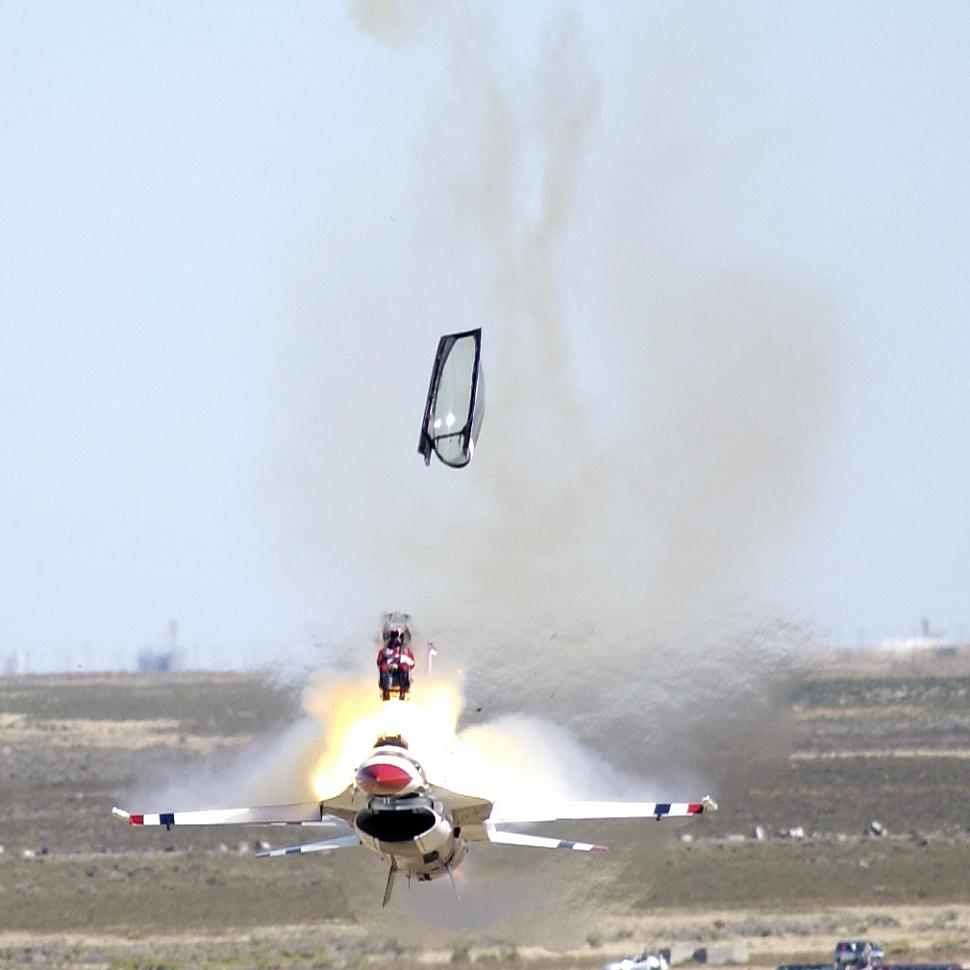Fighter Jet News
F-16 Fighting Falcon News
Thunderbird crashes at Idaho air show
September 15, 2003 (by
Lieven Dewitte) -
An Air Force Thunderbird F-16C crashed and exploded during an air show in Mountain Home, Idaho, Sunday afternoon. The pilot managed to eject from the F-16 and was uninjured.
The crash happened shortly after the Thunderbird demonstration started. According to witnesses, the plane was the sixth and last to take off. It climbed straight into the sky and the pilot performed a barrel roll.
While upside down, the pilot maneuvered the jet into a dive. As the jet continued to dive, it appeared to have an engine failure when the pilot struggled to pull up.
The pilot, Capt. Kris Stricklin of Nellis Air Force Base in Nevada, safely ejected and parachuted to safety far from the crash site. He was treated by military medical personnel. No other injuries were reported.
The jet crashed near the air control tower and slid in a fiery ball across an open field.
The crash stunned an estimated 85,000 spectators at the "Gunfighter Skies 2003" air show. A spokeswoman said the Thunderbirds will continue to tour. An airshow is scheduled for Saturday and Sunday in Wichita, Kansas, then Janesville, Wisc. on Sept. 27 and 28.
The cause of the crash is under investigation.
About the pilot
Capt Chris R. Stricklin (31) is in his first season with the Thunderbirds and he flies the No. 6 jet as the Opposing Solo. He entered the Air Force in 1994 from the U.S. Air Force Academy. Before his assignment to the team, Capt Stricklin served as a F-15C flight commander, instructor pilot, and flight examiner with the F-15C Formal Training Unit, 1st Fighter Squadron, Tyndall Air Force Base, Florida. He has logged more than 1,500 hours as an Air Force pilot, with more than 1,200 hours in F-15 C/D and F-16 C/D.
About the Thunderbirds
On May 25, 1953, the U.S. Air Force's official air demonstration team, designated the 3600th Air Demonstration Unit, was activated at Luke Air Force Base in Arizona. The "Thunderbirds" name was soon adopted by the unit, influenced in part by the Indian culture and folklore of the southwestern United States where Luke is located.
Indian legends speaks of the Thunderbird with great fear and respect - when it took to the skies, the earth trembled from the thunder of its great wings. From its eyes shot bolts of lightning. Nothing in nature could challenge the bird of thunder, the story said, and no man could stand against its might.
The Thunderbirds have flown a variety of aircraft over the decades. Since in 1992, the team has flown Lockheed Martin's F-16C advanced jet fighter, the team's ninth aircraft.
See also the F-16.net Forum discussions: T-Bird Crash Accident Report Released and Thunderbird Crash 14 Sep 2003
While upside down, the pilot maneuvered the jet into a dive. As the jet continued to dive, it appeared to have an engine failure when the pilot struggled to pull up.
The pilot, Capt. Kris Stricklin of Nellis Air Force Base in Nevada, safely ejected and parachuted to safety far from the crash site. He was treated by military medical personnel. No other injuries were reported.
The jet crashed near the air control tower and slid in a fiery ball across an open field.
The crash stunned an estimated 85,000 spectators at the "Gunfighter Skies 2003" air show. A spokeswoman said the Thunderbirds will continue to tour. An airshow is scheduled for Saturday and Sunday in Wichita, Kansas, then Janesville, Wisc. on Sept. 27 and 28.
The cause of the crash is under investigation.
About the pilot
Capt Chris R. Stricklin (31) is in his first season with the Thunderbirds and he flies the No. 6 jet as the Opposing Solo. He entered the Air Force in 1994 from the U.S. Air Force Academy. Before his assignment to the team, Capt Stricklin served as a F-15C flight commander, instructor pilot, and flight examiner with the F-15C Formal Training Unit, 1st Fighter Squadron, Tyndall Air Force Base, Florida. He has logged more than 1,500 hours as an Air Force pilot, with more than 1,200 hours in F-15 C/D and F-16 C/D.
About the Thunderbirds
On May 25, 1953, the U.S. Air Force's official air demonstration team, designated the 3600th Air Demonstration Unit, was activated at Luke Air Force Base in Arizona. The "Thunderbirds" name was soon adopted by the unit, influenced in part by the Indian culture and folklore of the southwestern United States where Luke is located.
Indian legends speaks of the Thunderbird with great fear and respect - when it took to the skies, the earth trembled from the thunder of its great wings. From its eyes shot bolts of lightning. Nothing in nature could challenge the bird of thunder, the story said, and no man could stand against its might.
The Thunderbirds have flown a variety of aircraft over the decades. Since in 1992, the team has flown Lockheed Martin's F-16C advanced jet fighter, the team's ninth aircraft.
See also the F-16.net Forum discussions: T-Bird Crash Accident Report Released and Thunderbird Crash 14 Sep 2003
Related articles:
External link:
Forum discussion:
Tags
External link:
Forum discussion:
- Thunderbird crashes at Idaho air show ( 22 replies)
Tags

